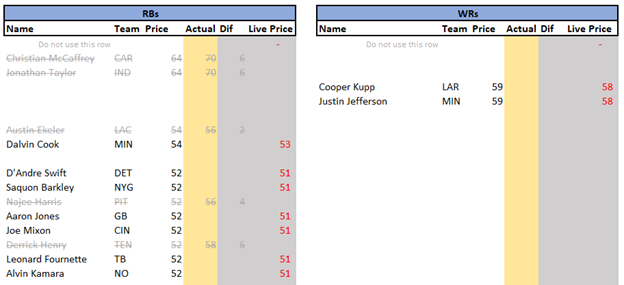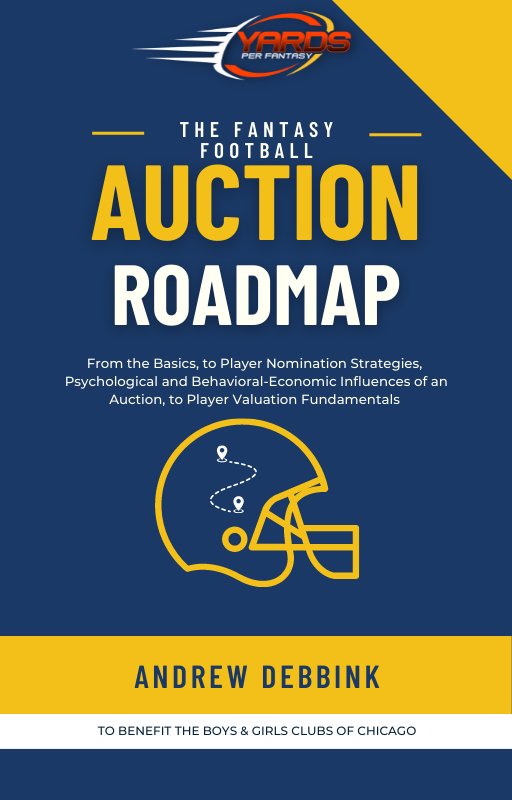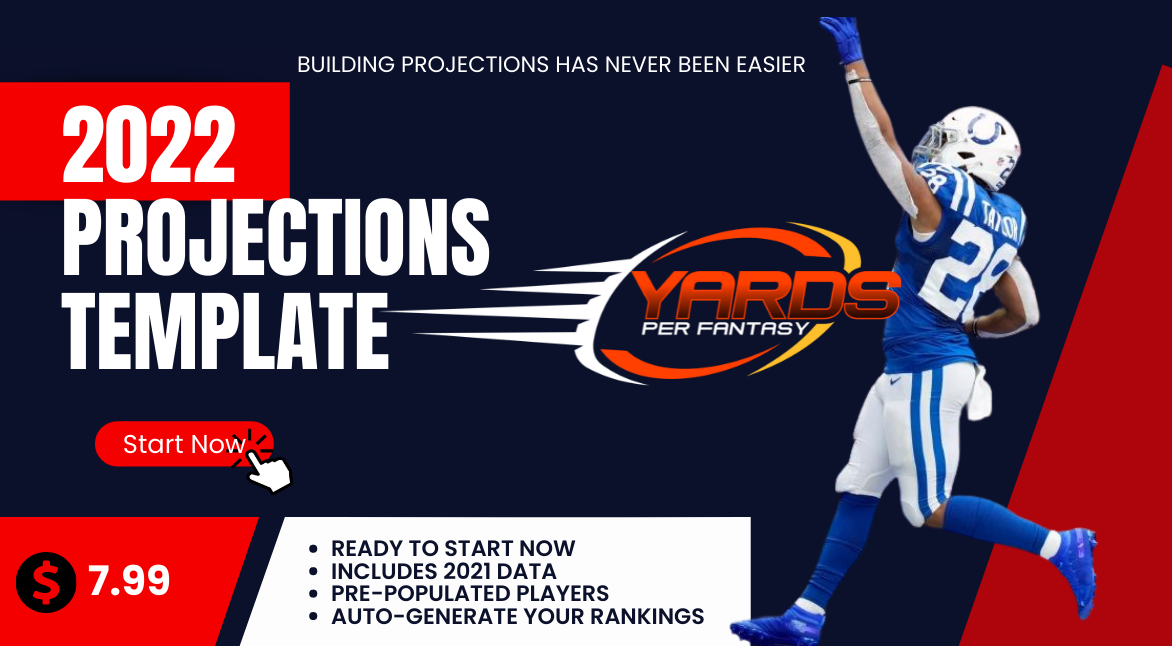 Draft With Us On Underdog! Use Promo-Code: YARDSPER for a 100% deposit match up to $100!
Draft With Us On Underdog! Use Promo-Code: YARDSPER for a 100% deposit match up to $100!
Ever been interested in trying an auction/salary cap draft but don’t know where to begin to prepare? Or have you been doing auction drafts for a few years, and want to take your preparation to the next level with a more principled, methodical approach? Whether you’re an experienced auction player or new to the format, I’m here to help you improve your preparation for auction/salary cap drafts!
The Fantasy Football Auction Roadmap is available for sale on Yards Per Fantasy for $9.99, with 100% of proceeds going to benefit the Boys and Girls Clubs of Chicago. The Roadmap provides a comprehensive look at the best ways to prepare yourself for an auction draft. Included in the Fantasy Football Auction Roadmap:
- Auction draft basics
- Psychological influences in an auction and how to use them to your advantage
- How to determine player values (conceptually and quantitatively)
- How to adjust player values based on the actual auction results
- Player nomination strategies both early and late in an auction
- Budgeting and roster construction strategies
- Personal favorite philosophies and strategies
- Applying fantasy football auction draft concepts in snake drafts and vice versa
- Draft day Excel document which provides:
- Player values (both superflex and non-superflex leagues)
- Adjustments to those values for “live prices” based on actual auction results
- Example budgets
- Personal targets and nomination targets
This article is part of a series of articles that will provide a free sneak peek at some of the types of concepts you can expect to learn about in the Roadmap. The following are the previous articles in this series:
In this article, we’ll explore the Purchase Price Allocation and why it is the single most important thing you can do to prepare yourself for an auction draft.
What is a Purchase Price Allocation?
In the business world, a company might purchase another company that contains multiple assets for a single agreed upon price. That is, when you purchase an entire business, you likely will not stipulate separate prices for each of the assets you are acquiring; rather, you will agree to a single purchase price that represents the combined value of all of the assets acquired. Nevertheless, the purchasing company must separately report the value of the various assets it acquired from the transaction on its financial statements (and how much it acquired them for). But how does the company determine the amount it acquired each individual asset for when it paid a single lump sum price?
The answer is that the company must perform what is called a “purchase price allocation” (“PPA”). A PPA requires a company to allocate the total price paid for a set of assets amongst those assets individually. The basis for this allocation is the relative standalone values of each of the assets (i.e., the price you would pay to acquire an asset if you were to purchase it separately).
For example, Company A purchases Company B for a total of $1 million. Within Company B, there are 4 main groups of assets: a building worth $600,000, a fleet of cars worth $300,000, equipment worth $100,000, and other supplies worth $100,000. The following table illustrates how the $1 million purchase price would be allocated amongst the assets acquired to show how much was paid for each item.
 The righthand column is what would ultimately be recorded in Company A’s financial statements as the amount that each of the various assets acquired for.
The righthand column is what would ultimately be recorded in Company A’s financial statements as the amount that each of the various assets acquired for.
Auction Draft = One Big PPA
Performing a PPA should be the basis of everyone’s auction draft preparation. In effect, that is all an auction draft is. Let’s illustrate with a 12-team, $200 budget league with 16- player rosters. You know that there will be 192 “assets” (players) acquired for a total “purchase price” of $2,400 (assuming all managers spend all their dollars). Thus, to prepare for an auction draft, you should allocate the $2,400 amongst each of the player 192 players that you believe should be drafted, based on each player’s relative standalone value in your view (which can be determined either quantitatively based on projections, or qualitatively). This allocation essentially represents your “answer key” of what the most efficient allocation of league auction dollars would be, where no ‘deals’ were had on any players.
Coming up with relative standalone values for each player should be based on a mixture of art and science. If you have a set of projections you trust, then there are quantitative methods to determine approximate standalone values for each player. This process is discussed more completely in the Roadmap. But even if you don’t use a mathematical approach, you should still qualitatively determine what you think an optimal allocation of the total auction dollars would be amongst the players to be drafted.
Whether you perform the allocation qualitatively or quantitatively, it is essential that the allocation of total auction dollars 1) ties back exactly to the amount of dollars available, and 2) is allocated amongst the exact number of players that will be drafted. There should not be a mismatch in either respect.
Having your own personal PPA going into an auction draft is the single most powerful tool you can have at your disposal on draft day. Some may ask why it is so important to perfectly tie out your auction dollars and number of players, even though it is a near-certainty that the real auction values for each player will be different than our allocation. In reality, it is exactly this fact that makes a PPA allocation so powerful. We KNOW the auction results will be different from our PPA, with some players selling for more than your PPA price and some selling below. Since we know players will sell below your PPA prices, you should demand a discount on every player you win relative to your PPA.
You can find my personal set of PPA values for a 1QB league here.
Example
Let’s take an example of how we can use this to our advantage on draft day. Suppose the following results for the first five nominations in your draft:
 Tracking actual prices against your own PPA prices will provide you with information about when value is created or realized on your board, and how you should adjust your prices and expectations mid-auction. The Draft Day Document you receive with your copy of the Auction Roadmap provides a template that allows you to track these differences, AND has a built in formula to automatically adjust your PPA prices to “live prices” based on actual results of the auction.
Tracking actual prices against your own PPA prices will provide you with information about when value is created or realized on your board, and how you should adjust your prices and expectations mid-auction. The Draft Day Document you receive with your copy of the Auction Roadmap provides a template that allows you to track these differences, AND has a built in formula to automatically adjust your PPA prices to “live prices” based on actual results of the auction.
In the example above, each of the first five players nominated ultimately sold for amounts above their PPA price (taken from the Roadmap). This then creates $24 of value on your board, which is accumulated and displayed within the draft day document:

Because of the aggregate overpay in the results so far, it means you should demand a discount on the players remaining on the board, because we know there will be discounts to be had. The Draft Day Document automatically adjusts the prices of remaining players to their new, live PPA price based on their relative standalone PPA prices and the amount of auction dollars remaining.
You’ll note in the picture above that the live prices have been adjusted down, essentially reallocating the overspend from the first five players amongst the players yet to be nominated.
Conclusion
Performing a purchase price allocation that reconciles back to 1) the total auction dollars and 2) the total number of players to be selected is single most important piece of preparation an auction drafter should do. Understanding what your personal, optimal allocation of auction dollars is provides you a ceiling on what you would ever pay for each player. In fact, you should demand a discount on that price, knowing that the results of your auction will inevitably be different than your PPA allocation.








